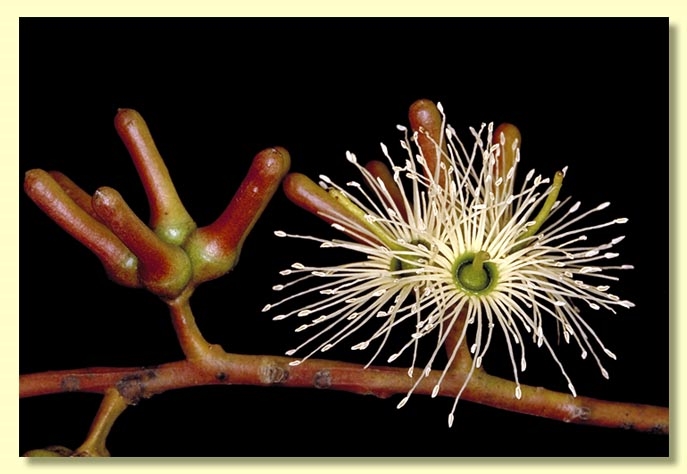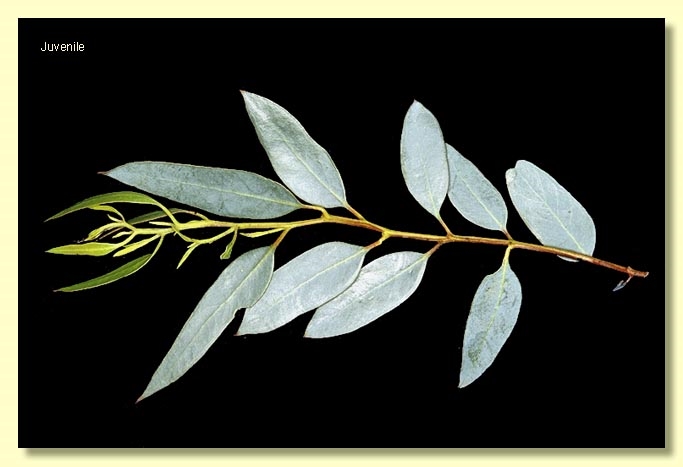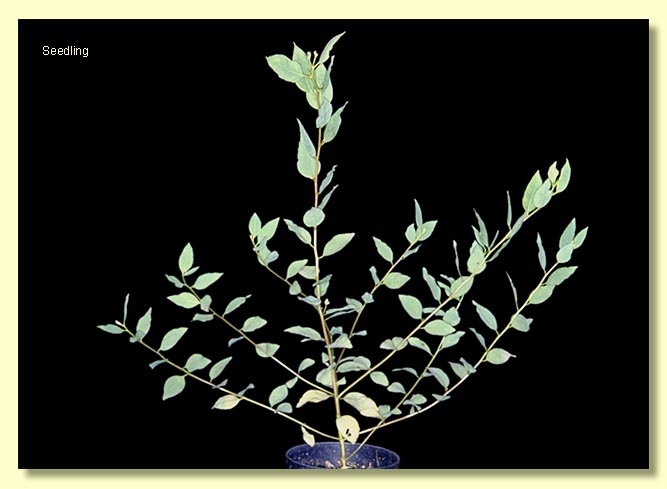Eucalyptus | Symphyomyrtus | Bisectae | Glandulosae | Erectae | Annulatae
Euclid - Online edition
Eucalyptus annulata
Bark usually smooth throughout, of 'oily' appearance, grey and red-brown to yellowish green.
Branchlets with pith oil glands.
Juvenile growth (coppice or field seedlings to 50 cm): stems square in cross-section; juvenile leaves opposite, sub-opposite to alternate, petiolate, ovate to lanceolate, 4–7.5 cm long, 1.3–2 cm wide, blue-green for ca 20–30 cm of growth then green.
Adult leaves alternate, petioles 0.7–1.8 cm; blade narrowly lanceolate, 6–11.5 cm long, 0.7–1.7 cm wide, base tapering to petiole, margin entire, apex pointed, concolorous, glossy, green, side-veins greater than 45° to midrib or side-veins and reticulation obscured by numerous oil glands, intramarginal vein present.
Inflorescence axillary, single, peduncle broadly flattened, erect, 0.4–1.5 cm long, buds 7 per umbel, sessile or sometimes shortly pedicellate (pedicels 0–0.4 cm long). Mature buds elongated, stout, (1.2–2.6 cm long, 0.5–0.7 cm wide) slightly curved, scar present, operculum not tapering much, blunt at apex or dilated, ca 4 times as long as the cupular hypanthium and narrower at the join, stamens erect, anthers narrowly oblong, weakly versatile, sub-basifixed, dehiscing by longitudinal slits, style straight, long, stigma, more or less tapered, locules 4, the placentae convex, each with 4 to 6 vertical ovule rows or the rows indistinct. Flowers creamy to pale yellow.
Fruit on erect or down-turned peduncles, usually sessile or rarely shortly pedicellate (pedicels 0–0.3 cm long), hemispherical to cupular, 0.8–1.2 cm wide, sometimes angled slightly, disc descending vertically, valves 4, strongly exserted.
Seeds brown, 1–2.5 mm long, cuboid to ovoid, dorsal surface with numerous more or less parallel fissures only near the margin, centre of dorsal surface more or less smooth, sides ridged or scarcely so, margin hardly toothed, hilum ventral or more or less terminal. (Seedcoat often referred to as being honeycombed.)
Cultivated seedlings (measured at ca node 10): cotyledons Y-shaped (bisected); stems square in cross-section, smooth or slightly warty; leaves always shortly petiolate, opposite for 5 to 7 nodes then alternate, ovate, 3–4.5 cm long, 1.5–2.5 cm wide, dull, mid-green.
Flowering has been recorded in August, September and October.
A mallee with smooth bark, endemic to Western Australia, occurring in southern sub-coastal districts and the southern wheatbelt from Katanning and Pallinup River east to near Mt Ney, characteristically on heavy-soiled flats.
Eucalyptus annulata belongs in Eucalyptus subgenus Symphyomyrtus section Bisectae subsection Glandulosae because the buds have two opercula, the cotyledons are bisected and the branchlets have numerous oil glands in the pith. Within this subsection E. annulata belongs in series Erectae subseries Annulatae because of its erect stamens and long operculum, leaves with crowded round oil glands concealing the sideveins and reticulation, and smooth bark. There are 3 species in subseries Annulatae - E. annulata and the mallets E. extensa and E. protensa.
E. protensa is restricted to the area from south of Norseman to near Balladonia, and E. extensa is found from north of Salmon Gums to Hyden and Southern Cross. Both E. protensa and E. extensa are mallets. E. protensa has more or less terete peduncles, buds with slender pedicels and finely elongated opercula, whilst E. extensa has broadly flattened peduncles, buds with short pedicels and long but not finely elongated opercula. E. annulata also has broadly flattened peduncles, buds that are sessile to shortly pedicellate, and slightly shorter opercula that are often dilated apically. In the Nyabing area several collections have been made in recent years of rough-barked trees that show similarity with both E. annulata and E. extensa.
E. annulata is more distantly related to the gimlets (series Contortae) by habit and bark type and the prominently exserted valves of the fruit. It also has seed somewhat like that of the gimlets, but the seedcoat is much less markedly fissured although the margins are still ragged. The gimlets also differ in having irregularly star-shaped oil glands in the leaves. E. annulata also shares characters with E. eremophila and related species (series Erectae subseries Abundae), viz. erect stamens and leaves with crowded round oil glands obscuring the venation.













